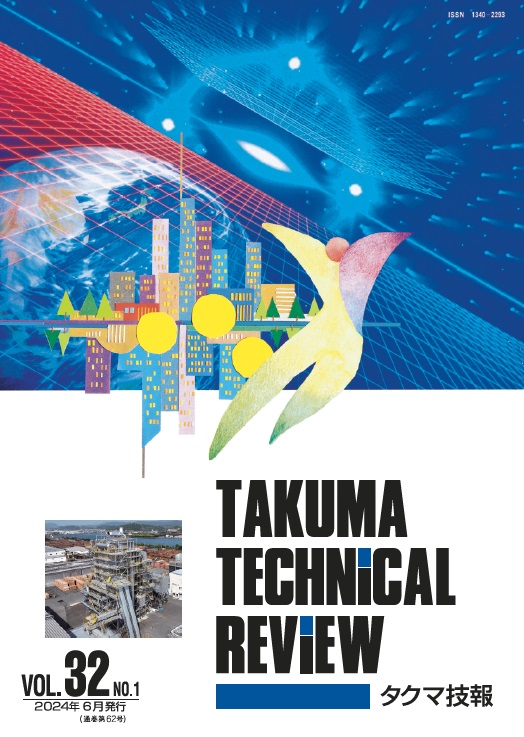

(Abstract)
Each industry is making various efforts to achieve carbon neutrality by 2050. In the 6th Strategic Energy Plan, the industrial and consumer sectors, which are the main sales targets for our products, will focus on thorough energy conservation, and electrification using decarbonized electricity and the use of hydrogen, synthetic methane, and synthetic fuels. Also this Plan requires the efforts of all involved. The general-purpose boilers manufactured and sold by our company are devices that primarily burn fossil fuels to supply heat. Therefore, unless we reduce CO2 emissions from combustion to virtually zero, we cannot contribute to carbon neutrality. This paper introduces industry trends surrounding general-purpose boilers and our decarbonization technology.
(Abstract)
In order to achieve carbon neutrality by 2050, it is considered essential to capture and recover carbon dioxide from carbon dioxide emission sources such as incineration exhaust gas, and store and immobilize it. Our company has been working on the development of a chemical absorption technique, which is one of the carbon dioxide capture and recovery technologies, and conducted various examinations under the research project adopted in 2021 and commissioned by the national research and development agency New Energy and Industrial Technology Development Organization (NEDO), as part of the development. This article reports the results of our feasibility study on retrofitting the energy-saving carbon dioxide capture and recovery process to an existing biomass power generation plant, and the results of our investigation on the utilization requirements of the recovered carbon dioxide.
(Abstract)
Methane fermentation of municipal solid waste contributes to help more stably operate facilities by increasing energy recovery, resulting in increase of electric power sales, and to reduce greenhouse gases. In this study, we experimentally investigated fermentation characteristics of methane fermentation with addition of fats and oils to artificial municipal solid waste, and a mixing effect of fat and oils on the fermentation, and then evaluated biogas production and concentration. A vegetable oil and an animal fat could be respectively fermented under the mass ratios of 70% or lower and 33% or lower without any problem. The fermentation tests showed an increase of the biogas production and the methane concentration with an increase of the mass ratio. In addition, the conditions under high mass ratio demonstrated low ammonia concentration in the fermentation liquid, resulting in reduction in the wastewater treatment cost. Therefore, increasing biogas production and biogas concentration by methane fermentation with the addition of oils to general wastes is expected to develop into a method that can simultaneous achieve an increase in biogas production and biogas concentration.
(Abstract)
Our company is advancing technology development for the labor-saving and automation of facilities and plants by utilizing digital technologies such as AI and ICT. As one of these initiatives, we are capturing the condition of plant equipment as images and using AI and image processing to classify and quantify this information for use. By recognizing the information that plant operators usually observe and pay attention to as numerical values, and treating images as a type of sensor data, for example, by setting thresholds to trigger alarms, we can provide operators with insights. In this report, we present the results of developing a system that obtains numerical information about the fuel condition from images of the inspection window of a biomass power plantʼs fuel supply feeder hopper and detects bridge conditions.
(Abstract)
Our company promotes development for the purpose of advancing garbage crane automation and homogenizing the garbage in a garbage pit more thoroughly than the conventional automatic stirring control. In the past, we reported on the development of a system which reflected the visual sense (variation in color tones) of the operator to automatically control the garbage crane by quantifying it as the Garbage Mixing Degree in Takuma Technical Review Vol. 28 and Vol. 31. On the other hand, since it may be possible to carry out a higher level of garbage pit management by knowing the properties of the garbage at each pit address, including information on the inside of the garbage, we are jointly developing with Okayama University a new system to collectively manage information from the point of carrying in the garbage to its injection into the incinerator. This system is designed to estimate the garbage properties at each address by managing the information of the garbage pit through developing a three-dimensional garbage pit, and reproducing the behavior of garbage and moisture. This article describes the basic model of the system and reports the current development status.
(Abstract)
IIn June 2023, we delivered the power generation equipment: Chugoku Mokuzai Biomass Power Plant (Hyuga No. 2) to Regional Power Co., Ltd. This power plant adopts the circulating fluidized bed type as combustion method, and it is the fourth domestic facility delivered by our company. It is also the first circulating fluidized bed boiler facility fueled by woody biomass and applying the feed-in tariff scheme. This article introduces an outline of the equipment and reports on the operation results.
(Abstract)
Kahoku County City Clean Center, which we completed in March 2023 after receiving an order from Kahoku County City Wide Area Affairs Association, is used to incinerate waste and consolidate sludge treatment, and uses part of the steam generated during incineration to dry the sewage sludge that is generated from four sewage treatment plants with a steam indirect heating type of sewage sludge dryer. The dried sludge is used as a heat source for power generation by being co-combusted with the waste. This article provides an introduction to the sewage sludge dryer, and reports on its operation status.